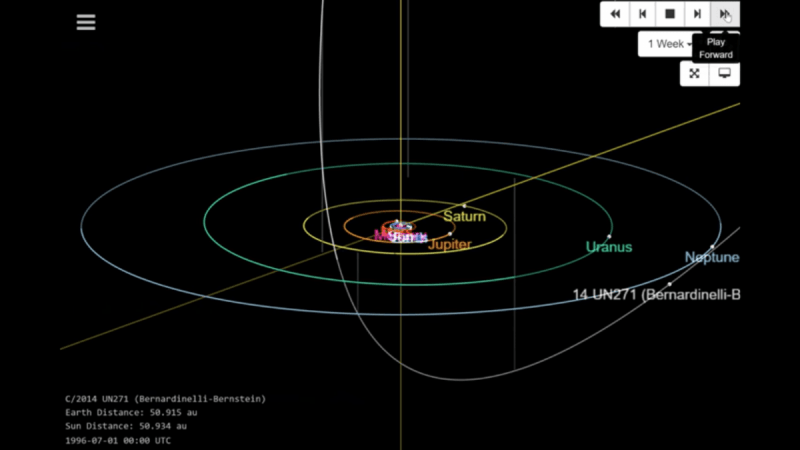According to new research, the Bernardinelli-Bernstein comet (C/2014 UN27) is on its approach to the inner solar system. It will make a near encounter with the Sun in 2031.
Bernardinelli-Bernstein is perhaps the world's biggest and most beautiful comet. It has a diameter of approximately 150 kilometres and a mass 10 times that of the Hale Bopp comet. The huge comet's closest approach to the Sun will be 10.95 AU (Astronomical Units) from the star.

Is it going to pose a threat to the Earth?
Well, the answer is no. This will pass closest to Earth between the orbits of Saturn and Uranus, and over 1 billion miles from the sun.
Bernstein-Bernstein is 1.8 billion kilometres from the sun. The ice rock is coming from "beneath," meaning below Earth's orbit around the sun. It'll spin up near Saturn's orbit, and then head back out to the solar system's depths.
The comet would be so far away from Earth that people will need a telescope to see it. This isn't the comet's first journey to the solar system. According to the findings, comet BB passed within 18AU of the Sun 3.5 million years ago.
However, if it were to crash, the result would be devastating for Earth's existence. Fortunately, NASA maintains a Planetary Defense Coordination Office that monitors the skies for potentially harmful space junk and can alert users to possible impacts.
"One day, mankind may create spacecraft capable of diverting potentially harmful asteroids or comets away from the planet," said Jean Creighton, an astronomer and director of the University of Wisconsin - Milwaukee's Manfred Olson Planetarium.

When was the first time a planet was struck by a comet?
Comets are extremely uncertain and chaotic in their behaviour. If a comet were to collide with the Earth, we would receive little notice and would not have enough time to take precautionary measures. Jupiter collided with the comet Shoemaker-Levy 9 in 1994. The consequences of the collision extended over an area four times the size of the Earth.
Although all collisions happened on Jupiter's side away from Earth, they were typically near the spot on Jupiter that was about to be seen by Earth. Since certain impact locations were visible minutes after the explosion by the telescope.
From July 16 to 22, 1994, huge fragments of comet Shoemaker-Levy 9 (SL9) smashed onto Jupiter. It was the first live comet to be spotted circling a planet, caught by Jupiter 20–30 years ago. Massive black scars were seen in the planet's atmosphere and hot plumes into the stratosphere.
It's more than a freak show, though. It allowed scientists to learn more about Jupiter, Shoemaker-Levy 9, and cosmic impacts in general. "This could be the most significant event of their careers for comet astronomers and planetary specialists worldwide," NASA said before the event.





!['Had denied Housefull franchise as they wanted me to wear a bikini': Tia Bajpai on turning down bold scripts [Exclusive]](https://data1.ibtimes.co.in/en/full/806605/had-denied-housefull-franchise-they-wanted-me-wear-bikini-tia-bajpai-turning-down-bold.png?w=220&h=138)



